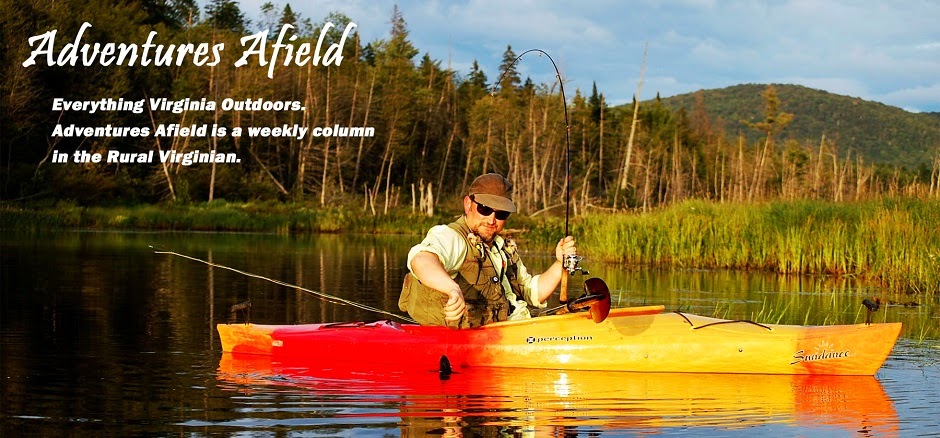As one with knowledge only of a life spent outdoors, I
arrange my memories by seasons. By morning dew and the reflection of warm genesis
on fresh leaves, I remember days casting dry flies to feisty brook trout and
wild rainbows. By thick, starlit nights and the chug-chugging of a popper I recall extended summer evenings
fishing for heavy bigmouths from a canoe. By the first chilly, gray morning in
September, and the sight of yellow leaves adhered by mist to the rocks of a
Blue Ridge Mountain hollow, I remember those days spent toting a .22 long
rifle, ears perked to the sound of bushytail toes on bark. That morning is fast
approaching.
 |
| Photo by Matt Reilly |
This Saturday, September 3, Virginian small game enthusiasts
will be given the annual go-ahead to target their favorite quarry—gray
squirrels, and the less prominent red and fox squirrels.
The season on red squirrels and the widely distributed gray
squirrels will run through February 28, statewide.
Fox squirrels are legal game only through January 31, and
can only be taken in the counties west of the Blue Ridge, and in the counties
of Albemarle, Bedford, Culpeper, Fauquier, Franklin, Greene, Loudoun, Madison,
Orange, Patrick, Prince William, and Rappahannock.
The traditional bag limit of a combined six bushytails
remains in place.
Three Different Seasons
Dedicated squirrel hunters enjoy pursuing game with a wide
range of implements. Muzzleloaders, riflemen, shotgunners, archers, and
airgunners all set their sights on bushytails, both from carefully scouted
stands and conveniently located saplings during a still hunt. The right method
for you is largely up to preference and ability. However, the Virginia squirrel
season is a long one, and so it is worth noting the limitations and strengths
of different tactics during the three distinct seasons the squirrel hunter will
face between September and February.
The month of September and early October I call the “early
season”. Leaves and acorns still cling to the forest canopy, and squirrels
haven’t yet been shot at. Often, this makes finding squirrels easy. They are
loud, shaking large bunches of foliage while mining acorns from the treetops,
and the foliage somewhat robs them of their bird’s eye view of the forest
floor.
I rarely hunt squirrels in September. In Virginia, the
weather is generally still quite warm. However, when I do, I rarely stand-hunt.
The squirrels are occupied and relatively stationary high in the treetops.
Thus, my favorite way to hunt is to simply wander the woods with an eye on the
sky, looking for roiling bunches of foliage. Once a squirrel is located, an
easy stalk is usually all that separates one from a shot.
The length of that shot varies by the cover you hunt, but
keep in mind that it can be difficult due to foliage to get a clear shot with a
small bore .22 rifle or an airgun. A 20 gauge with a modified choke can be an
excellent choice for sorting through all those limbs and leaves, and is often
my first choice in the early season.
I call the “mid-season” that period starting in the latter
days of October, and lasting until most of the fallen mast has been used up and
there is snow on the ground—usually sometime in mid- to late-December. During
this season, the squirrels have been educated a little, but they spend a
significant portion of their day on the ground, scrounging for acorns. The
forest canopy has thinned, and a longer, more precise shot it possible.
During this period, stand hunting can be quite effective.
Locate areas where there is a concentration of fallen mast, like a hardwood
creekbottom or flat oak grove. White oaks tend to drop acorns earlier than red
oaks, so know your local hardwood species, and pay attention to their
mast-producing tendencies.
A longer line of sight makes a .22 or air gun very valuable,
and will provide more shots from a stand. The subtle crack of the rifle is also
less alerting, compared to the invasive boom
of a shotgun, enabling a shorter recovery to seclusion.
The doldrums of winter I consider to be the “late season.”
Food is scarce and the woods are bare. Squirrels are spooky and ranging wide.
Leaves are crunchy due to cold. What’s more, groups of squirrels are often
spotted chasing each other as a mating ritual.
 |
| Photo by Matt Reilly |
These reasons make me partial to a very slow still-hunt with
a shotgun. Educated squirrels often stick tight to cover when approached, and
make mad dashes for cover, making moving shots common. You may be lucky enough
to have several squirrels chase each other to within range, in which case,
multiple quick shots can pay dividends.
Keep these variables in mind when planning your days afield
this fall and winter chasing Virginia’s favorite small game species.
*Originally published in the Rural Virginian









